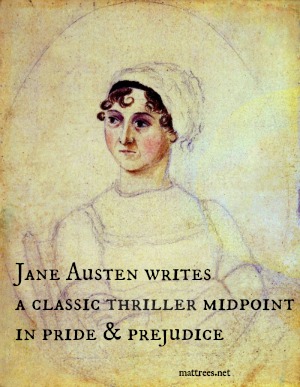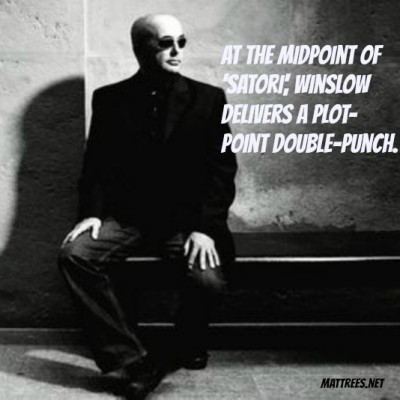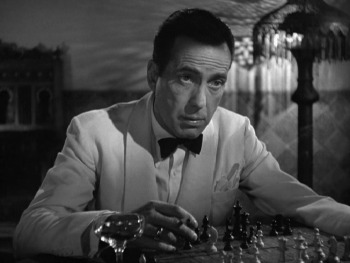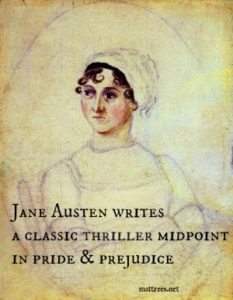The Midpoint is key to the pace of a thriller structure — and many other genres
When you structure a thriller, pay special attention to the plot point called the Midpoint.
Write a good Midpoint as you plot a novel and you’ll propel your readers into the second half of your book with spectacular impetus.
What is the Midpoint? It falls directly in the center of the story structure (which may not be precisely in the middle of the book by page number, but probably is close.) The Midpoint is a scene that shifts the context and momentum of the story. It could be big or small. It could shift the story 45 degrees or 180. But it absolutely must push the story up a gear or two.
Thriller structure builds hero character
The main result of the Midpoint is a change in the hero. In the first half of Act II, the hero reacts to the situation around him. At the Midpoint, the hero becomes an action figure, powering through the second half of Act II in a more proactive mode.
 Jane Austen, thriller novelist
Jane Austen, thriller novelist
That doesn’t mean this only works for action heroes. That master of the thriller genre Jane Austen writes a classic Midpoint in Pride and Prejudice, when Mister D’Arcy proposes to Lizzie Bennett, only for her to reject him and tell him she hates all he stands for. After that, there’s no more dancing around each other, no coming together just because we like Lizzie and want her to marry a nice, rich guy. They have to act, or they aren’t going to end up as a couple.
Imagine your novel as a ship (at least, a ship contemporary to Miss Austen). The Midpoint is the mainmast, while the first and second plot points are the foremast up front and the mizzen at the back. Sure, there are ships with only two masts. But they don’t move as fast or as powerfully as a ship that’s built around a big, impressive, driving mainmast. Novels without a mainmast won’t move as quickly either, no matter how much wind the author supplies.
Midpoint story structure checklist
Here are a few ways to build a Midpoint that propels the hero into the second half of Act II with major momentum:
• Introduce a new character whose presence adds to the danger. In Gorky Park, Martin Cruz Smith gives his detective a new American pal who turns out to have a big impact on the denouement.

• Change the nature of the threat to the hero. Don Winslow does this in Satori and gives us a 180 degree twist. The reader spends the first half of the book thinking the hero has to carry out a hit for the CIA to buy his freedom from a US military jail. Instead, at the Midpoint, Winslow delivers a plot-point double punch. The hero kills his target — at great risk and with much tension. Only to have the CIA immediately try to kill him. For the rest of the book, he faces entirely unexpected risks as he figures out why he was double-crossed and goes after the men he believes did it.
• Introduce new information. Bridget Jones learns her boyfriend Mark is involved with another woman in Bridget Jones’s Diary. Jack Reacher finds reason to suspects the woman he’s involved with might be the killer in The Affair.
• Kill someone, to heighten the element of danger and provide a new impetus for the hero’s chase. I admit I like this one. I’ve used it in several of my novels. In Mozart’s Last Aria, the great composer’s sister is about to learn who killed him, only for her informant to be murdered during a performance of “The Magic Flute.” She’s back to square one, but now she’s sure there’s a murderer and that he’s onto her.
The show 24 tends to use the 180-degree Midpoint, too. Ever noticed how Jack Bauer fights one lot of bad guys for the first 12 hours, only to realize halfway through the season that the real bad guy is someone else entirely with a completely different plan?
What does a good Midpoint do?
A good Midpoint moves the plot faster. But best of all the reader experiences the same startling shift in focus as the hero. That creates tension and conflict. Which is a good thing in any plot. It’s also a way of saying to the reader, “Gotcha. Stay tuned, because I have more like that for Act III.”
Always try to make the Midpoint blow your readers away. Devote as much energy and ingenuity to it as you do to the set-up of the novel. Never make it so subtle it passes unnoticed. Think of The Da Vinci Code. The Midpoint of Dan Brown‘s novel is the discovery of what the Holy Grail really is. That’s pretty earth-shattering, even as Midpoints go.
Got a clock? Find the Midpoint
 It isn’t only novelists who use this thriller structure technique. Screenwriters tend to be particularly precise about having their Midpoint land exactly 50 percent of the way through the movie. Midpoint-spotting in movies is, therefore, pretty easy (provided you own a clock) and can be very instructive as a plot exercise.
It isn’t only novelists who use this thriller structure technique. Screenwriters tend to be particularly precise about having their Midpoint land exactly 50 percent of the way through the movie. Midpoint-spotting in movies is, therefore, pretty easy (provided you own a clock) and can be very instructive as a plot exercise.
Check out Casablanca. At the exact middle of the movie, Rick harshes out at Ilsa. She runs off. He’s left in the bar thinking about what a terrible man he has become. Which propels him to spend the second half of the movie redeeming himself.
Let me know if there’s a great Midpoint that I haven’t mentioned.

 Write a thriller: Bad experiences make you a better writer
Write a thriller: Bad experiences make you a better writer
In most thrillers and spy novels, the third act is much shorter and faster paced. Therefore, the midpoint is well past the 50% mark in the book. More around the 60-65% mark.
It’s still about the middle of the book, Dan, but point taken. In Hollywood scripts it comes right at the center usually, in terms of time and script pages. Also there are the same number of plot “beats” before and after the midpoint. That’s really the key, I suppose.